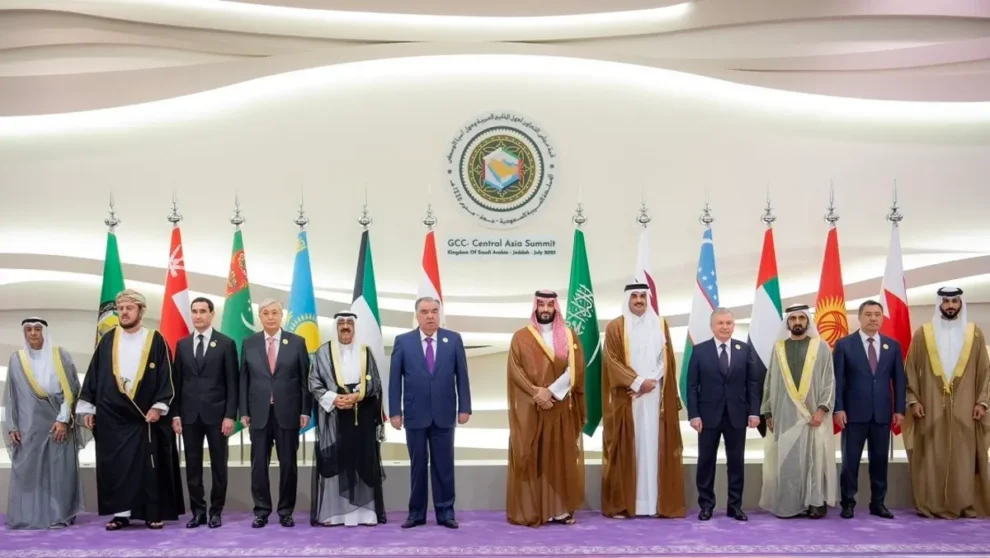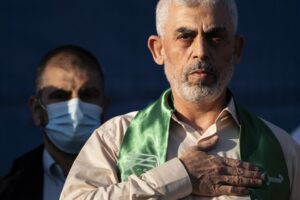The leaders of the five Central Asian states — Kazakhstan, Kyrgyzstan, Tajikistan, Turkmenistan and Uzbekistan, known collectively as the C5 — met their Gulf Cooperation Council counterparts in Jeddah last week for a GCC-C5 summit.
This gathering built on the success of a ministerial meeting between the C5 and GCC in Riyadh last year.
Central Asia is at a crucial geopolitical crossroads. Muslims, Christians and Jews, alongside the Turkic, Slavic and Persian peoples, have cohabited the vast steppe for centuries. Located between Europe and Asia, Central Asia straddles two major energy-consuming markets.
For millennia the region served as one of the key routes for East-West trade on the Eurasian landmass. Today, billions of dollars are being invested in connecting the region with the rest of the world. Like spokes on a wheel, new and modernized roads, pipelines, fiber optic cables, and rail lines are being constructed connecting Central Asia to East Asia, Europe and South Asia. There is a potential for new connections with the Middle East, too.
In addition to the big players — the US, the EU, Russia and China — other powers, including Iran, India, Pakistan and Turkey, are playing increasingly important roles in Central Asia. Some of them have shared interests, often they are competitors. This creates a tangled web of alliances and interests in what is already a complicated neighborhood. It makes sense that the GCC would be interested in deepening its relations in the region as well.
Meanwhile, the five Central Asian republics need and want, to varying degrees, more engagement with regional powers and groupings such as the GCC. For the countries of the C5, geopolitics is a constant balancing act in relation to the bigger powers. The more engagement they have with outside powers, the more secure they feel when dealing with bigger regional powers such as Russia, China or even Iran.
There is an important economic component as well. According to the World Bank’s Global Economic Prospects report, published last month, economic growth in Central Asia is expected to remain flat this year, at 4 percent.
The impact of an ailing Russian economy has spillover effects across the region. Countries such as Kyrgyzstan, Tajikistan and Uzbekistan have been hit hard by lower remittances from Russia and the knock-on effect of international sanctions against Moscow.
But it is not all bad news. The energy sector has driven significant growth in Kazakhstan. There is huge potential for energy-sector growth in Turkmenistan, too. The World Bank expects economic growth in Central Asia to increase modestly in 2024. Countries such as Kazakhstan and Uzbekistan have made efforts to modernize their economies, fight corruption, and at least partially privatize many state-owned enterprises.
The region is also attracting record amounts of foreign direct investment. There is already a burgeoning economic relationship between the GCC and the C5, with great potential to enhance it.
During last week’s summit in Jeddah, a Joint Action Plan for Strategic Dialogue and Cooperation was agreed by GCC members and the Central Asian states. The plan, which covers the period from 2023 to 2027, offers an opportunity for both sides to deepen their economic, trade, security and cultural relationships. Looking ahead, there are four things that the members of the GCC can do to enhance relations with the Central Asian republics.
Firstly, the GCC should appoint a special envoy for Central Asia. This individual could serve as the primary interlocutor for the Gulf states in the region, and devote the required time and energy needed to develop personal relationships across Central Asia. This would help maintain a degree of continuity between GCC-C5 summits.
Secondly, Gulf policymakers must avoid the temptation to view the five Central Asian republics as a single bloc. The region consist of five independent and sovereign states. While they share some aspects of a common history, each retains its own distinct identity, culture and global outlook.
It is therefore likely that the GCC will be able to increase its cooperation with some Central Asian republics more than with others. Decision-makers should keep this in mind when developing policies for the region.
Thirdly, the GCC should prioritize interconnectivity between the two regions. There is already an ambitious project, the Dry Canal corridor, that intends to create a link between Iraq’s southern Gulf coast and Turkish ports by 2038.
With creative and ambitious thinking, the Gulf states could use this project to connect with markets in the South Caucasus and Central Asia using the Middle Corridor, a tried-and-tested trade route connecting Turkiye to Central Asia, bypassing Russia and Iran. Air connectivity should be increased between the regions, too.
Finally, the GCC should consult and, when appropriate, coordinate with Turkiye. In recent years, the country’s economic, cultural and security influence has been on the rise across Central Asia. Kazakhstan, Kyrgyzstan, Uzbekistan and Turkmenistan are culturally and linguistically Turkic, and the bonds between these countries and Turkiye are close.
These four Central Asian countries are also members of the Organization of Turkic States. It might be worth considering a summit between that organization and the GCC. The fact that Turkish president Recep Tayyip Erdogan toured the Gulf just days before the GCC-C5 summit was either a lucky geopolitical coincidence or a masterstroke in strategic thinking by Gulf policymakers.
The next GCC-C5 Summit will take place next year in Samarkand, Uzbekistan. The connection between the Arab world and Samarkand goes back centuries. When the famous 10th-century Arab geographer and writer, Ibn Hawqal, visited Samarkand, he wrote in 977 AD: “Everywhere you look in the city, you see beautiful places and feel it pleasant.”
Not only is it right that the next gathering be held in Central Asia, but the choice of Samarkand has historical and symbolic significance. As one of the most important cities along the old Silk Road, it represents the glorious past of Central Asia and the potential of its future.
If the right steps are taken now, the GCC-C5 relationship can flourish well into that future.
Source: Eurasia Review















